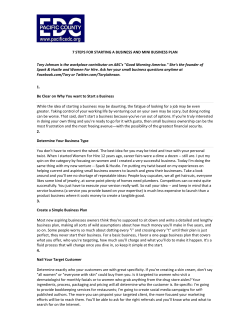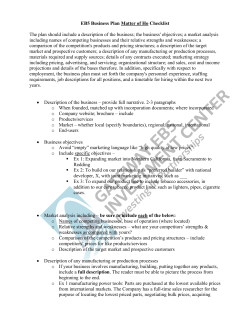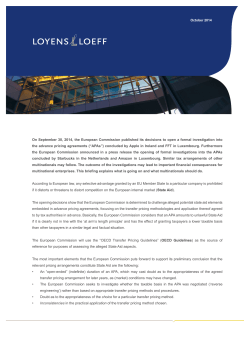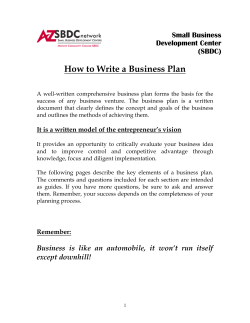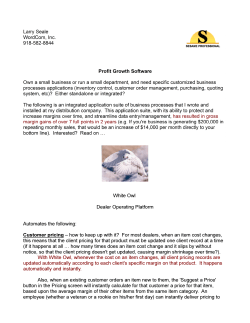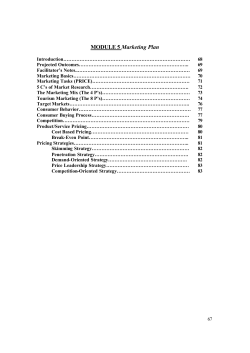
Procurement in Industrial Management – BPT 3133 Price and Cost Analysis
Procurement in Industrial Management – BPT 3133 Price and Cost Analysis CHAPTER OUTLINE Introduction Price Determination Objective, Process and Factors Price Analysis Variables that influence an item’s price Cost Analysis Techniques : cost-based, break-even Obtain Prices INTRODUCTION Price = Monetary terms Price often depends on circumstances: “ you pay more to fly when you want to fly ” Some consumers are very interested in getting a low price and pay close attention to price There is a tendency to link quality with price Consumers are often prepared to pay more if they expect to get excellent service Adding value doesn’t mean dropping price PRICE DETERMINATION In pricing, an organization first must decide on its pricing objective / goal. The next step is to set the base price for a product. The final step involves designing pricing strategies that are compatible with the rest of the marketing mix. Many strategic questions must be answered: Will our company compete on the basis of price or other factors? What kind of discount schedule (if any) should be adopted? Pricing Objectives Management should decide on its pricing objective before determining the price itself. Profit-oriented Achieve a target return — pricing product to achieve a specified percentage return on sales or investment. Maximize profits — followed by the most companies. Sales oriented Increase sales volume. Maintain or increase market share. Status quo Stabilize prices. Meet competition. The Process: An Illustration SELECT PRICING OBJECTIVE SELECT METHOD OF DETERMINING THE BASE PRICE Price based on both demand and costs Cost-plus pricing Price set in relation to market alone DESIGN APPROPRIATE STRATEGIES • Price vs. nonprice competition • Skimming vs. penetration • Discounts and allowances • Freight payments • One price vs. flexible price • Psychological pricing • Leader pricing • Everyday low vs. high-low pricing • Resale price maintenance Factors Affecting Price Decisions Internal Factors 1. Marketing Objectives 2. Marketing Mix Strategy 3. Product Cost 4. Organizational considerations Pricing Decisions External Factors 1. Nature of the market & demand 2. Competition 3. Environmental factors (economy, resellers, government) Marketing Objectives Survival Low Prices to Cover Variable Costs and Some Fixed Costs to Stay in Business. Marketing Objectives Current Profit Maximization Choose the Price that Produces the Maximum Current Profit, Etc. Market Share Leadership Low as Possible Prices to Become the Market Share Leader. Product Quality Leadership High Prices to Cover Higher Performance Quality and R & D. Marketing Mix Customers seek products that give them the best value in terms of benefits received for the price paid Product Design Nonprice Positions Price Promotion Distribution Pricing Strategies : Product Mix Optional-Product Pricing optional or accessory products sold with the main product. i.e camera bag. Captive-Product Pricing products that must be used with the main product. i.e. film. Pricing Strategies : Product Mix By-Product Pricing low-value by-products to get rid of them and make the main product’s price more competitive. Eg.: sawdust ProductBundling Combining several products and offering the bundle at a reduced price. Eg. : theater season tickets Pricing Strategies F.O.B. Point-of-Production pricing: Price quoted at factory- buyer pays transportation. Uniform delivered pricing: Same delivered price quoted to all; works if transportation costs small. Zone-delivered pricing: Set same price within several zones Freight-absorption pricing: Seller absorbs transport cost to penetrate market. Firms may adopt a one-price strategy or charge different prices to different customers Flexible pricing strategies: shoppers may pay different prices if they buy the same quantity Pricing Strategies :Psychological Considers the psychology of prices and not simply the economics. Customers use price less when they can judge quality of a product. Price becomes an important quality signal when customers can’t judge quality; price is used to say something about a product. PRICE ANALYSIS Determine if the price offered is appropriate without examining the specific cost and profit calculations (cost details) Price been compared with: 1. Other price offers 2. Prices previously paid 3. Going rate if applicable 4. Prices charged for alternatives which could substitute for what is offered Any prices well below the norm should be examined with care Major Considerations in Setting Price PRICE ANALYSIS Variety of variables that directly and indirectly influence an item’s price Market structure Price mechanism & competition conditions Economic conditions Pricing strategy of the seller Detail analysis of internal cost structures Market-Driven Pricing Models Using the producer price index to manage price Market Structure Price mechanism Competition conditions Price Supply Supplier’s Market Conditions Monopoly One supplier Duopoly Two supplier Monopolistic Many suppliers, Differentiated product Perfect Many suppliers, Same product Monopsony One buyer, Many supplier Buyer’s Market Demand Market Price Competition Volume or Quantity Market Driven Pricing Models 1. Price volume models Supplier analyzes the market to find the combination of price per unit and quantity of sales that maximizes its profit on the assumption that : Lower price will result more units being sold Greater volume will spread the indirect cost over more units 2. Market Share Model Based on assumption that long-run profitability depends on the market share obtained by the supplier (penetration pricing) Market Share Model Use Under These Conditions: Market Must be Highly Price-Sensitive so a Low Price Produces More Market Growth. Production/ Distribution Costs Must Fall as Sales Volume Increases. Must Keep Out Competition & Maintain Its Low Price Position or Benefits May Only be Temporary. Market Penetration Setting a Low Price for a New Product in Order to “Penetrate” the Market Quickly and Deeply. Attract a Large Number of Buyers and Win a Larger Market Share. Market Driven Pricing Models 3. Market-Skimming Model Prices are set to achieve a high profit on each unit by selling to supply managers who are willing to pay for products or services of perceived higher value 4. Promotional Pricing Model Pricing for individual products that is set to enhance the sales of the overall product line 5. Revenue Pricing Model Obtaining sufficient current revenue to pay for operating cost – during market slowdowns Market-Skimming Model Market Skimming Setting a High Price for a New Product to “Skim” Maximum Revenues from the Target Market. Results in Fewer, But More Profitable Sales. Use Under These Conditions: Product’s Quality and Image Must Support Its Higher Price. Costs Can’t be so High that They Cancel the Advantage of Charging More. Competitors Shouldn’t be Able to Enter Market Easily and Undercut the High Price. Promotional Pricing Model Involves setting price steps between various products in a product line based on: Cost differences between products Customer evaluations of different features Competitors’ prices. Market Driven Pricing Models 6. Competition Pricing Model Pricing actions or reactions to pricing proposals offered or expected to be offered by the supplier’s competitors Determine the highest price that can be offered that will still be lower than the price offered by competitors 7. Cash Discounts Offer incentives to pay invoices promptly Payment with certain period of time Competition Pricing Model Setting Prices Going-Rate Company Sets Prices Based on What Competitors Are Charging. ? ? Sealed-Bid Company Sets Prices Based on What They Think Competitors Will Charge. Cash Discount Adjusting Basic Price to Reward Customers For Certain Responses Cash Discount Seasonal Discount Quantity Discount Trade-In Allowance Functional Discount Promotional Allowance COST ANALYSIS It looks at one aspect only : how quoted price relates to cost of production Useful technique for keeping prices realistic in the absence of effective competition Concentrates attention on what costs ought to be incurred before the work is done Cost Analysis Techniques Cost-based pricing models Cost-markup pricing model Margin pricing model Rate-of-Return pricing model Product specification Estimate supplier costs using reverse price analysis Break-even analysis Cost-Based Pricing Model Certainty About Costs Price Competition is Minimized Much Fairer to Buyers & Sellers Unexpected Situational Factors Pricing is Simplified Cost-Plus Pricing is an Approach That Adds a Standard Markup to the Attitudes Costofof the Product. Others Simplest Pricing Method Ignores Current Demand & Competition Cost-Markup Pricing Model Mark-up = 20% = RM18 Cost and profit = 100% = RM72 MANUFAC TURER Mfg selling price = 100% = RM72 Cost = 80% = RM72 WHOLE SALER Mark-up = 40% = RM60 W/s Cost selling = 60% price = RM90 = 100% = RM90 RETAILER Retailer’s selling price = 100% = RM150 Cost to Consumer = RM150 CONSUMER Margin Pricing Model Unit Selling Price = (Cost) + (Margin Rate)(Cost) Example : Cost - RM 50 Margin Rate – 25% Unit Selling Price = RM 50 + (0.25)(50) = RM 50 + RM 12.50 = RM 62.50 Cost – 100% MR 25% Unit Selling Price Rate-of-Return Pricing Model Unit Selling Price = Unit Cost + Unit Profit Example : Supplier wanted a 20% return on its investment of RM 300,000 (which might include R&D, equipment, etc.) to make 4000 parts with a total cost of RM50 each. Unit Selling Price = RM 50 + (0.20)(RM 300,000) 4000 = RM 50 + RM 15 = RM 65.00 Reverse Price Analysis Also known as “Should Cost” analysis Evaluating whether a supplier’s price is justifiable and reasonable Hypothetical Price RM 20 Profit (15%) RM 3 Subtotal RM 17 Direct Material RM 4 Subtotal RM 13 Direct Labor RM 3 Mfg. Burden RM 10 Purchaser should attempt to initiate discussion in the following areas to discover opportunities for cost reductions : 1. Plant Utilization 2. Process Capability 3. Learning-Curve Effect 4. The Supplier Workforce 5. Management Capability 6. Purchasing Efficiency Break-Even Analysis To identify the point where revenue equals cost & the expected profit/loss at different production volumes. Strategic planning tool – to estimate expected profit or loss over a range of sales Break-Even : TR = TC = VC + FC Break-Even Analysis Fixed costs: These are costs that are the same regardless of how many items you sell. All start-up costs, such as rent, insurance and computers are considered fixed costs since you have to make these outlays before you sell your first item. Variable costs: These are recurring costs that you absorb with each unit you sell. For example, if you were operating a greeting card store where you had to buy greeting cards from a stationary company for $1 each, then that dollar represents a variable cost. As your business and sales grow, you can begin appropriating labor and other items as variable costs if it makes sense for your industry. Break-Even Analysis Example : Purchase or Sale Price - RM 10 Variable Cost per Unit – RM 6 Fixed Cost – RM 30,000 Break-Even Unit : TR = VC + FC RM10 (x) = RM6 (x) + RM 30,000 RM4 X = RM 30,000 X = 7,500 units Net Income / Loss = TR – (VC + FC) How Buyers Obtain Prices A price list is made available Prices are quoted on request Potential suppliers submit sealed bids or tenders Purchase are made at auction or by reverse auction By negotiation
© Copyright 2025
